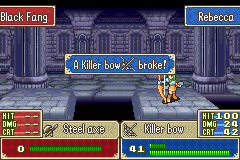| Site News |
|---|
| Warning: This wiki contains spoilers. Read at your own risk! Social media: If you would like, please join our Discord server, and/or follow us on X (Twitter) or Tumblr! |
Durability
| This page has been marked as a stub. Please help improve the page by adding information. |
A weapon or item's durability or uses is a value which tracks the number of times it can be used to attack before it breaks and is no longer usable. Every time a weapon is used to attack an enemy, or every time an item is used, its durability value decreases by 1, often expressed as "using one use" of the weapon. The durability system is present in all Fire Emblem series games except Gaiden.
In general, there is a pattern to a weapon's durability relative to its might, weapon rank and other stats: typically, the weakest weapons in the game (eg Iron Sword or Fire) will have significantly higher usage (typically around 45) than stronger weapons of higher rank (eg Silver Sword and Bolganone, typically at 20 uses), and often rare staves with unusual effects (eg Silence, Hammerne) will have even lower usage than that. The primary exception is Seisen no Keifu, in which nearly all weapons will have 50 uses, though rare staves will still have just 1-5. In most games there is an inconsistency related to a weapon's durability being consumed when it misses: missing an attack with a physical weapon will not decrease its durability, but a magic attack missing will still cost one use.
In most games, a weapon or item will disappear entirely when its durability reaches 0. The exceptions are Monshou no Nazo, Seisen no Keifu and Thracia 776, in which once a weapon breaks it becomes a Broken Sword, Broken Lance, Broken Axe, Broken Bow, Empty Book or Broken Staff depending on its original weapon type. These remnants allow the player an extra opportunity to have the weapon repaired through the weapon-repair system of the game in question, or can simply be discarded if unwanted. In these cases, non-weapon items are not able to repaired.
Durability restoration and alteration systems
- Most games feature the Hammerne staff, which restores a weapon to full durability; however, Hammerne is typically rare with only one available per playthrough, and itself has very low durability. Hammerne is absent only in Gaiden (which doesn't feature durability), Seisen no Keifu (which has a separate system) and Thracia 776 (which instead has the otherwise identical Repair staff). Often there are weapons, such as Dragonstones or other instances of Hammerne, which cannot have a Hammerne used on them.
- In Seisen no Keifu's castle towns, all units can readily access a weapon repair shop, which fully restores a weapon's durability for a fee equivalent to a fraction of the weapon's base worth.
- From Shadow Dragon onward, two separate instances of the same weapon can be merged together in the battle preparations menu, combining the remaining uses of both weapons into a single weapon. However, in Awakening, this cannot be done to forged weapons.
- In Awakening, the Armsthrift skill available to Mercenaries grants its user a chance of the durability of their weapon not decreasing, at a rate of (Luck x 2)%. With this skill, it is possible to never have durability decrease at all by equipping it to a unit who has 50 or greater Luck (for example, Owain will have the potential to reach a maximum 51 Luck if Donnel was his father, as will all other units if they also bear Limit Breaker).
- A small number of weapons across the series, sometimes enemy-exclusive for the most part, have no durability value and will never break. Examples include the Falchion, Ragnell, Alondite and Amiti.
